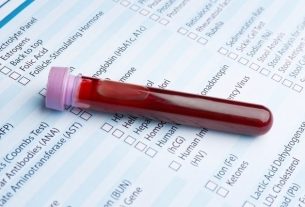The fasting blood glucose test is used to measure the level of glucose in the bloodstream, being useful for investigating the diagnosis of diabetes, and for monitoring the blood sugar levels of people who are diabetic or at risk for this disease. The normal fasting glucose value is up to 99 mg/dL.
Fasting blood glucose, or fasting glucose, needs to be done after a fast of 8 to 12 hours in duration, or as directed by your doctor, without consuming any food or drink except water.
Furthermore, to obtain more reliable results, this test can be requested in conjunction with others that also assess these changes, such as the oral glucose tolerance test (or OGTT) and glycated hemoglobin, especially if changes are found in the glucose test. In fasting. Find out more about the tests that confirm diabetes.

Fasting blood glucose reference values
The reference values for fasting blood glucose are:
- Normal fasting blood glucose: inferior a 99 mg/dL;
- Altered fasting blood glucose: entre 100 mg/dL e 125 mg/dL;
- Diabetes: equal to or greater than 126 mg/dL;
- Low fasting blood glucose or hypoglycemia: equal to or less than 70 mg/dL.
To confirm the diagnosis of diabetes, when the blood glucose value is equal to or greater than 126 mg/dl, it is necessary to repeat the test another day, as at least 2 samples are recommended, in addition to the possibility of carrying out a blood sugar test. glycated hemoglobin and oral glucose tolerance test.
Blood glucose calculator
To better understand the results of the glucose test, enter your result in the calculator below:
What does the result mean
The result is considered normal when fasting blood glucose is up to 99 mg/dL and diabetes when the value is equal to or above 126 mg/dL.
When the test values are between 100 and 125 mg/dL, it means that fasting blood glucose is altered, that is, the person has pre-diabetes, a situation in which the disease has not yet set in, but there is an increased risk of developing. Find out more about what prediabetes is and how to treat it.
Fasting blood glucose testing during pregnancy is part of the prenatal routine and can be done in any trimester of pregnancy, however the reference values are different. Thus, for pregnant women, when fasting blood glucose is above 92 mg/dL, it may be a case of gestational diabetes, however, the main test for diagnosing this condition is the glycemic curve or OGTT. Find out what the glycemic curve test means and how it is done.
How to prepare for the exam
Preparation for the fasting blood glucose test includes not ingesting any food or drink that contains calories for at least 8 hours, and not exceeding 12 hours of fasting. See more about fasting for the blood test.
It is recommended to maintain your usual diet in the week before the exam and, in addition, it is important not to consume alcohol, avoid caffeine and not practice rigorous exercise the day before the exam.
Who should take the exam
This test is usually requested by doctors to screen for diabetes or to monitor blood glucose levels in people who have already been diagnosed with diabetes and are undergoing treatment.
This investigation is usually carried out for all people over 45 years of age, every 3 years, but it can be carried out in younger people or in a shorter period of time, if there are risk factors for diabetes, such as:
- Diabetes symptoms such as excessive thirst, excessive hunger and weight loss;
- Family history of diabetes;
- Sedentary lifestyle;
- Obesity;
- Low HDL (good) cholesterol;
- High pressure;
- Coronary heart disease, such as angina or heart attack;
- History of gestational diabetes or birth of a child with macrosomia;
- Use of hyperglycemic medication, such as corticosteroids and beta-blockers.
In cases of altered fasting blood glucose or impaired glucose tolerance detected in previous tests, it is also recommended to repeat the test annually.
Bibliography
- AMERICAN DIABETES ASSOCIATION. Standards of Medical Care in Diabetes. 2017. Disponível em: <https://care.diabetesjournals.org/content/diacare/suppl/2016/12/15/40.Supplement_1.DC1/DC_40_S1_final.pdf>. Acesso em 03 out 2019

Sign up for our newsletter and stay up to date with exclusive news
that can transform your routine!
Warning: Undefined array key "title" in /home/storelat/public_html/wp-content/plugins/link-whisper-premium/templates/frontend/related-posts.php on line 12
Warning: Undefined array key "title_tag" in /home/storelat/public_html/wp-content/plugins/link-whisper-premium/templates/frontend/related-posts.php on line 13



